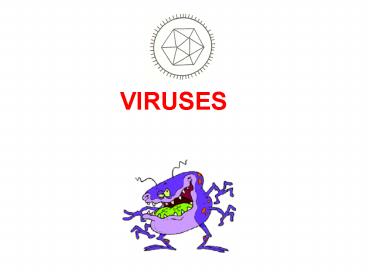VIRUSES - PowerPoint PPT Presentation
1 / 15
Title:
VIRUSES
Description:
VIRUSES What is a virus? A virus is a submicroscopic infectious particle composed of a protein coat ( ) and a nucleic acid core ( ) Viruses are similar in ... – PowerPoint PPT presentation
Number of Views:441
Avg rating:3.0/5.0
Title: VIRUSES
1
VIRUSES
2
What is a virus?
- A virus is a submicroscopic infectious particle
composed of a protein coat ( ) and a nucleic
acid core ( ) - Viruses are similar in size to a large protein
macromolecule, generally smaller than 200 nm in
diameter.
3
Discovery of Viruses
- Search for cause of tobacco mosaic disease led to
viruses - The elusive virus was crystallized in 1935 by
Stanley
4
(No Transcript)
5
Fig. 19-2
RESULTS
Extracted sap from tobacco plant
with tobacco mosaic disease
Passed sap through a porcelain filter known to
trap bacteria
Rubbed filtered sap on healthy tobacco plants
1
2
3
Healthy plants became infected
4
6
Viral Capsids
- Capsids are built from protein subunits called (
) - May be rod-shaped ( ), polyhedral (
) or more complex - Some viruses have membranous envelopes that help
them infect hosts (flu virus) - ( ), also called phages, are
viruses that infect ( )
7
Fig. 19-3
RNA
Membranous envelope
Head
DNA
RNA
DNA
Capsomere
Capsid
Tail sheath
Tail fiber
Capsomere of capsid
Glycoproteins
Glycoprotein
18 ? 250 nm
7090 nm (diameter)
80200 nm (diameter)
80 ? 225 nm
50 nm
50 nm
50 nm
20 nm
(a) Tobacco mosaic virus
(b) Adenoviruses
(c) Influenza viruses
(d) Bacteriophage T4
8
- Viruses are obligate intracellular parasites,
which means they can reproduce only within a host
cell - Each virus has a ( ), a limited number of
host cells that it can infect
9
Viral Reproduction
- Once a viral genome has entered a cell, the cell
begins to manufacture viral proteins using the
host cells materials (enzymes, ribosomes, tRNAs,
amino acids, ATP, etc.)
10
Fig. 19-4
VIRUS
Entry and uncoating
1
DNA
Capsid
Transcription and manufacture of capsid
proteins
3
Replication
2
HOST CELL
Viral DNA
mRNA
Capsid proteins
Viral DNA
Self-assembly of new virus particles and
their exit from the cell
4
11
- Phages are the best understood of all viruses
- Phages have two reproductive mechanisms the (
) and the ( )
12
The Lytic Cycle
- The lytic cycle culminates in the death of the
host cell by producing new phages and digests the
hosts cell wall, releasing the progeny viruses - A phage that reproduces only by the lytic cycle
is called a ( ) - Bacteria have defenses against phages, including
( ) that recognize and cut up certain
phage DNA
Animation Phage T4 Lytic Cycle
13
Fig. 19-5-5
Attachment
1
2
Entry of phage DNA and degradation of host DNA
5
Release
Phage assembly
4
Assembly
3
Synthesis of viral genomes and proteins
Head
Tail
Tail fibers
14
The Lysogenic Cycle
- The lysogenic cycle replicates the phage genome (
) the host - The viral DNA molecule is ( ) into the
host cells chromosome and is called a prophage. - Every time the host divides, it copies the phage
DNA and passes the copies to daughter cells - Viruses that can be lysogenic or lytic are called
( ) phages.
Animation Phage Lambda Lysogenic and Lytic Cycles
15
Fig. 19-6
Daughter cell with prophage
Phage DNA
The phage injects its DNA.
Cell divisions produce population of bacteria
infected with the prophage.
Phage DNA circularizes.
Phage
Bacterial chromosome
Occasionally, a prophage exits the
bacterial chromosome, initiating a lytic cycle.
Lytic cycle
Lysogenic cycle
The bacterium reproduces, copying the prophage
and transmitting it to daughter cells.
The cell lyses, releasing phages.
Lytic cycle is induced
Lysogenic cycle is entered
or
Prophage
Phage DNA integrates into the bacterial
chromosome, becoming a prophage.
New phage DNA and proteins are synthesized
and assembled into phages.































